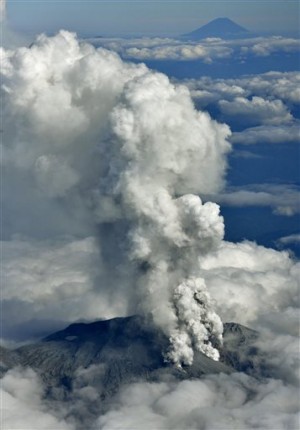Japan’s volcanoes: Could Fuji be next?

Dense fumes are spewed out from Mt. Ontake as the volcano erupts in central Japan Saturday, Sept. 27, 2014. Mount Fuji, Japan’s tallest mountain, is seen at top right. AP
TOKYO — The sudden eruption of Mount Ontake over the weekend, which is believed to have killed at least 31 people, was a reminder of Japan’s vulnerability to its many active volcanoes.
Gas continued to pour from the ruptured crater Monday, as emergency workers tried to reach the bodies of hikers trapped on the peak when it spat into life.
Ontake is one of 110 live volcanoes dotted throughout the seismically-active country, including Mount Fuji, the country’s tallest mountain and a Unesco World Heritage Site that welcomes some 300,000 walkers each year.
Fuji’s location just 100 kilometers (60 miles) from Tokyo adds an extra element of concern to its inclusion on the list of 47 volcanoes believed to be at risk of eruption in the coming century.
While Japanese authorities watch them closely for signs of activity, rare and unpredictable events such as the sudden eruption of Ontake, which had been largely quiescent for 35 years, bring home the impossibility of out-guessing Mother Nature.
Article continues after this advertisement“What happened on Saturday was beyond our current prediction methods,” said Toshitsugu Fujii, head of the Japan Meteorological Agency.
Article continues after this advertisementBefore it began spewing a deadly blanket of ash, rocks and steam, Mount Ontake had a Level One warning attached, the lowest on a five-point risk scale.
A Level Five warning requires the evacuation of nearby towns, but Level One — currently held by Mount Fuji — means no particular restrictions for hikers.
Mount Ontake has now been raised to Level Three, and people have been advised not to approach.
Emergency plan
According to a government study published in June, 80 percent of inhabited areas threatened by the effects of a potential nearby volcanic eruption have no evacuation plan.
Shizuoka Prefecture, home to Mount Fuji, is preparing for the possible rude awakening of its star attraction with an emergency procedure for local residents posted online.
It has also created an interactive website that simulates various paths red-hot lava might take in an eruption.
“For now we see no particular signs of activity, but a big eruption would result in more serious consequences and damage than other volcanoes, affecting many regions including Tokyo and its surrounding prefectures,” warns the 60-page evacuation plan produced by Shizuoka Prefecture in February.
In addition to the danger to those living nearby, Fuji’s eruption could cut off the main rail and road routes between Tokyo and Osaka, resulting in huge disruption to the national economy.
Earthquakes in Japan, which sits at the meeting place of four of the Earth’s tectonic plates, can trigger the eruption of volatile summits like Ontake, said Fujii.
“A very strong earthquake like that seen on 11 March 2011 (which caused a catastrophic tsunami) can heighten the risk of volcanic eruptions in the region due to an accumulation of magma,” he said in 2012.
And that’s just what happened the last time Fuji blew its top.
On 12 December 1707, just 49 days after a violent quake of magnitude 8.6 hit southern Japan, an explosive eruption of a vehemence rarely seen in history occurred there.
That eruption of Mount Fuji flung ash and smoke as high as 23 kilometres into the air, scientists have calculated.
This ash cloud blocked out sunlight as far away as Edo (now Tokyo) and formed a large new crater on the mountainside.
No deaths were reported from the eruption itself, which had no lava flow, but the ash covered farmland in the surrounding area, resulting in localized starvation.
Currently, four of the 47 volcanoes under surveillance are at alert level three, five at level two (danger near the crater), with the rest at level one or classed as without risk.
Of particular worry to volcanologists at the Japan Meteorological Agency are the islands of Miyakejima, Iwoto and Nishinoshima.
RELATED STORIES
More than 30 feared dead on Japan volcano – police